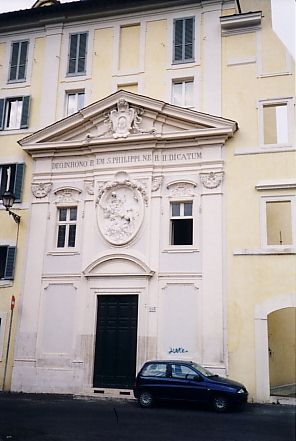
 |
The small church of San Filippo Neri, commonly called San Filippino owing to its small dimensions, was
erected in 1623 and originally dedicated to St. Trophimus (ć c. 280), first bishop of Arles in Gaul.
Since the founder of the church, Rutilio Brandi, a Florentine glovemaker and perfumer, suffered from gout, he dedicated it to this
particular saint, who is patron saint of the gouty. Brandi was a devout follower of St. Filippo Neri
(1515-1595), who with his Congregation of the Oratory constituted the centre of religious life in Rome. Brandi was inspired to found
the Confraternity of the Holy Wounds of Our Lord (Confraternita delle Piaghe di Nostro Signore Ges¨ Cristo), and the Conservatory of spinsters.
The conservatory had the care of 100 poor girls, whom they brought up until they either married or embraced religion. Brandi also
instituted a hostel for infirm priests. A small oratory was erected on Via del Malpasso, adjacent to the church proper.
According to ancient guide books the church was completely rebuilt in 1728 by Filippo Raguzzini (1680-1771),
commissioned by pope Benedict XIII (1724-1730), who granted an insignificant contribution of 500 scudi. However, the traditional
attribution to the Beneventan architect has recently been disproved on documentary grounds. Actually, the existing fašade was
constructed in 1767-1768 by the architect Giovanni Francesco Fiori (1709-1784).
|
 |
The two-storied fašade has a colossal order of pilasters. The capitals are decorated with shells and
hanging festoons. The central bay has a rectangular porch with an empty segmental pediment. Above this is an
oval stucco medallion with a relief depicting The Apparition of the Virgin and Child to St. Filippo Neri.
The medallion is crowned by floral garlands and a mussel-shell. The lateral bays have richly ornamented rectangular windows with
segmental pediments and, underneath these, plain panels. The fašade is crowned by a protruding triangular pediment with a cartouche
with the coat-of-arms of the Confraternity of the Holy Wounds of Our Lord adorned with a cherub's head and floral garlands. Beneath
the crowning pediment is the entablature with the dedicatory inscription of the church:
|
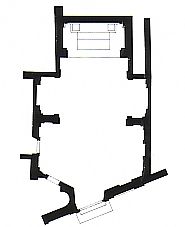 |
In 1853 the church of San Filippo Neri was severely damaged, when the Tiber flooded. It was restored at
the request of pope Pius IX (1846-1878), and the interior was embellished with lavish decorations and pictures.
In the late 1930's the Italian dictator Benito Mussolini ordered some large-scale demolitions in the
area with a view to building a road, dedicated to St. Filippo Neri, connecting Ponte Mazzini with Piazza della Chiesa Nuova along
Corso Vittorio Emanuele II. The church was partly demolished and abandoned. The paintings and other works of art of the interior
were removed. The high altar painting of St. Filippo Neri is by the 19th century artist Cesare Dies. The right side altar
had a medieval relief depicting The Crucifixion, which originated from the Grotte Vaticane. Above the left side altar was
Filippo Zucchetti's painting St. Trophimus healing the gouty (c. 1720). Other paintings adorning the interior were
a PietÓ and four canvases depicting The Passion of Christ. The small oratory housed the painting
Christ on the Mount of Olives, attributed to Federico Zucchari (1542-1609).
|
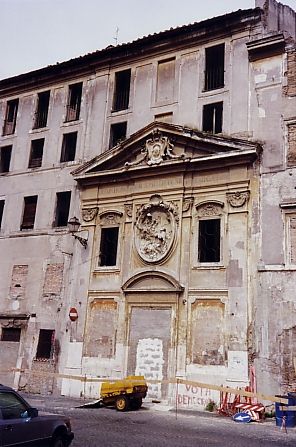 |
After World War II the project was postponed, and the church, which had been at the risk of being completely razed
to the ground, was saved. Abandoned and semi-demolished, the church was desecrated, and the windows were all smashed in. For a time the
interior served as a warehouse.
Finally, in 1993, a construction company was commissioned to restore the church of San Filippo Neri and
the adjacent buildings. Unfortunately the project was halted at some stages due to lack of funds, but by 1999 the restoration
was well under way.
|
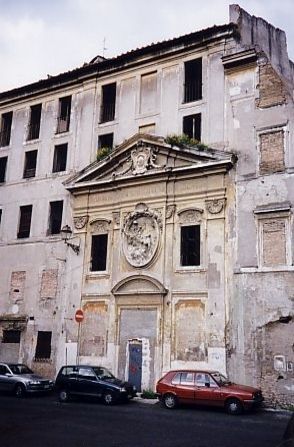 |
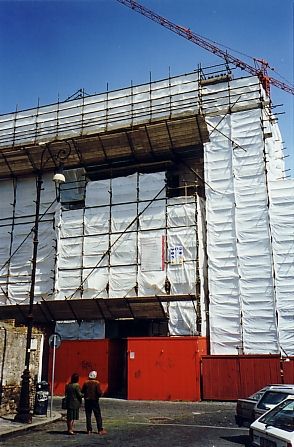
|
 |
At last, in 2000, the church of San Filippo Neri greeted the new millennium with a restored and cleaned
fašade! You may admire this fine example of 18th century ecclesiastical architecture at Via Giulia 134.
|